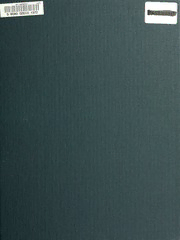Table Of ContentI
Digitized by the Internet Archive
in 2011 with funding from
Boston Library Consortium IVIember Libraries
http://www.archive.org/details/ivestimationwithOOhahn
Dm
,
IB31
.M415
Massachusetts Institute of Technology
Department of Economics
Working Paper Series
ESTIMATION WITH VALID AND INVALID INSTRUMENTS
IV
Jinyong Hahn
Jerry Hausman
Working Paper 03-26, First Draft
Please do not cite without authors' permission
July 15,2003
Room E52-251
50 Memorial Drive
Cambridge, MA 02142
This paper can be downloaded without charge from the
Social Science Research Network Paper Collection at
http://papers.ssrn com/paper.taf''abstract_icl=430061
rv Estimation with Valid and Invalid Instiniments
Jinyong Hahn and Jerry Hausman
UCLA
and IVUT
Abstract
While 2SLS is the most widely used estimator for simuhaneous equation models, OLS
may do better in finite samples. Here we demonstrate analytically that the forthe widely
used simultaneous equation model with onejointly endogenous variable and valid
instruments, 2SLS has smaller MSE error, up to second order, than OLS unless the R or
,
the F statistic ofthe reduced form equation is extremely low We then consider the
relative estimators when the instruments are invalid, e the instruments are correlated
i
with the stochastic disturbance. Here, both 2SLS and OLS are biased in finite samples
and inconsistent We investigate conditions under which the approximate finite sample
bias or the MSE of2SLS is smaller than the corresponding statistics for the OLS
estimator. We again find that 2SLS does better than OLS under a wide range of
We
conditions. then present a method ofsensitivity analysis, which calculates the
maximal asymptotic bias of2SLS under small violations ofthe exclusion restrictions. For
a given correlation between invalid instruments and the error term, we derive the
maximal asymptotic bias. We apply our results to IV estimation ofthe returns to
education We denve the bias in the estimated standard errors of2SLS for the first time.
This derivation also has implications for the test ofover-identifying restnctions.
Keywords: instrumental variables, 2SLS, weak instruments, retums to education
JEL codess; CI, C3
—
First Draft Please do not quote without permission
rV Estimation with Valid and Invalid Instruments
JinyongHahn and Jerry Hausman
July 15, 2003
While 2SLS is the most widely used estimator for simultaneous equation models,
OLS may do better in finite samples. Econometricians have recognized this possibility,
and many Monte Carlo studies were undertaken in the early years ofeconometrics to
attempt to determine condition when OLS might do better than 2SLS. Here we
demonstrate analytically that the for the widely used simultaneous equation mode! with
onejointly endogenous variable and valid instruments, 2SLS has smaller MSE error, up
to second order, than OLS unless the R" or the F statistic ofthe reduced fomi equation is
,
extremely low. We do a calculation based on observable statistics with one unknown
parameter that allows a calculation that should give valuable infomiation about the
relative MSEs ofOLS and 2SLS.
We then consider the relative estimators when the instruments are invalid, i.e. the
instnmients are correlated with the stochastic disturbance. Here, both 2SLS and OLS are
biased in finite samples and inconsistent. We investigate conditions under which the
approximate finite sample bias or the MSE of2SLS is smaller than the corresponding
statistics for the OLS estimator. We again find that 2SLS does better than OLS under a
wide range ofconditions, which we characterize as functions ofobservable statistics and
one unobser\'able stafistic.
We then present a method ofsensitivity analysis, which calculates the maximal
asymptotic bias of2SLS under small violations ofthe exclusion restrictions. For a given
correlation between invalid instruments and the error term, we derive the maximal
asymptotic bias. We demonstrate how such maximal asymptotic bias can be estimated in
practice.
Next, we turn to inference. In the "weak instruments" situation the bias in the
2SLS estimator creates a problem, since it is biased towards the OLS estimator, which is
also biased. The other problem that arises is that the estimated standard errors ofthe
2SLS estimator are often much too small to signal the problem ofimprecise estimates.
1
.
Here we derive the bias in the estimated standard errors for the first time, which turns out
to cause the problem. This derivation also has implications for the test ofover-
identifying restrictions.
We do not survey theweak instruments literature. Forrecent surveys see Stock
et. al. (2002) and Hahn and Hausman (2003).
I Model Specification
We begin with the model specification with one right hand side (RHS) jointly
endogenous variable so that the left hand side (LHS) variable depends only on the single
jointly endogenous RHS variable. This model specification accounts for other RHS
predetermined (or exogenous) variables, which have been "partialled out" of the
specification. We will assume that'
(1.1) y,=l3y,+e,
(1.2) yj =27:-, +V2,
where dim(;r2 )= K . Thus, the matrix z is the matrix of all predetermined variables, and
We
equation (1.1) is the reduced form equation for y^ with coefficient vector 71^. also
assume homoscedasticity:
fr \
n{q,y)~n
(1.3)
v^2,y (J. (J..
We
use the following notation:
h^ f^'\
y , o-,, = Var(f„ ), a^ = Var{v,,), cr^ = Cov(£-„,v,,)= a,
\.yn) \^nj
We initially assume the presence ofvalid instruments, E[z'e/Ji] = and 71:2 ^0
' Without loss ofgenerality we normalize the data such that yjhas zero mean.

